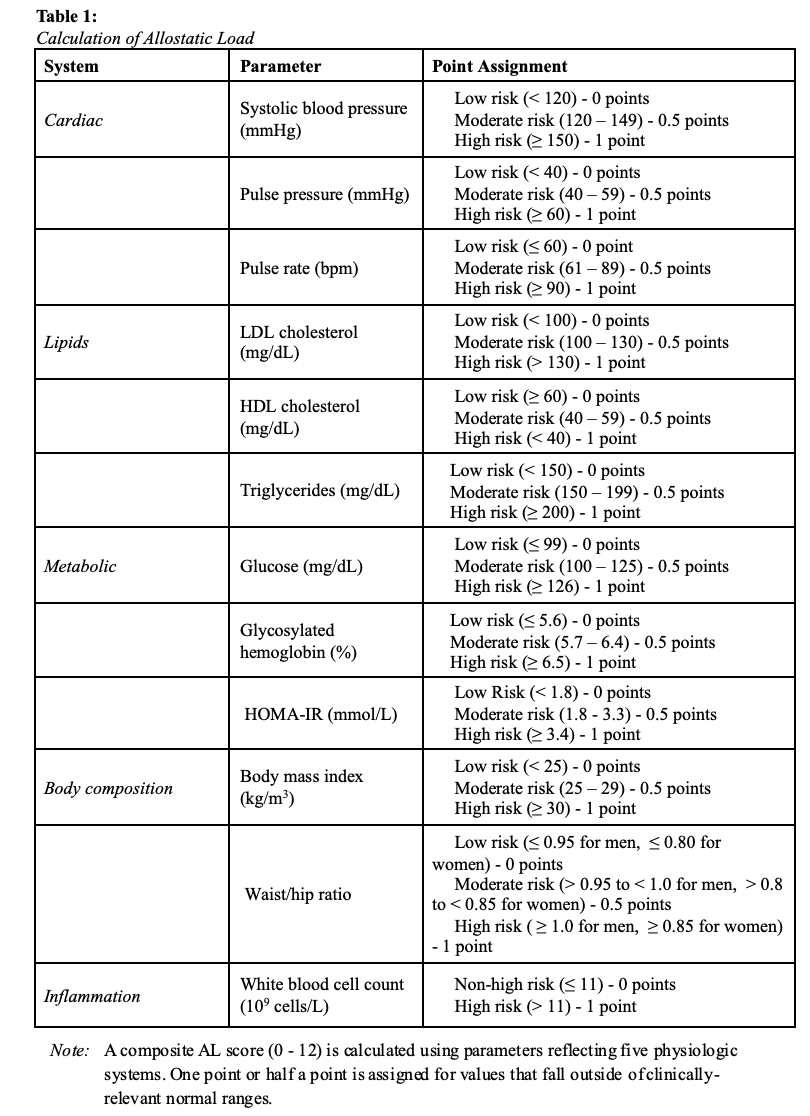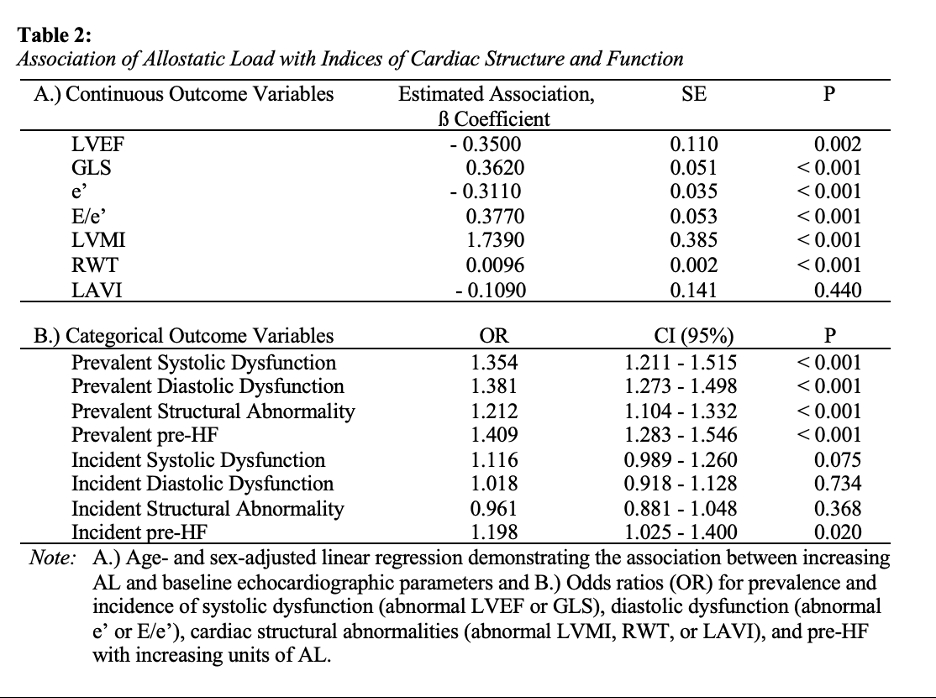Final ID: P1087
Impact of Allostatic Load on Prevalent and Incident Pre-Heart Failure in the Echocardiographic Study of Latinos (ECHO-SOL)
Abstract Body: Introduction
Allostatic load (AL) is multi-system index that physiologically quantifies the effects of chronic stress. The relationship of AL to pre-heart failure (HF), a precursor of clinical HF, has not been defined.
Methods
We studied 1,643 Hispanic/Latino adults who were free of clinical HF. An AL score was calculated using multiple physiologic parameters: (1) body mass index and waist hip ratio; (2) white blood cell count; (3) triglycerides, high-density lipoproteins, and low-density lipoproteins; (4) systolic blood pressure, pulse pressure and heart rate; and (5) serum glucose, insulin resistance, and glycosylated hemoglobin. For each parameter, points were assigned for values that fell outside normal ranges (Table 1). Echocardiographic measures of pre-HF were obtained across three domains: 1. systolic function (left ventricular ejection fraction [LVEF], global longitudinal strain [GLS]); 2. diastolic function (mitral inflow velocity [E], mitral annular early diastolic velocity [e’], E/e’); and 3. cardiac remodeling (left ventricular mass index [LVMI], relative wall thickness [RWT], and left atrial volume index [LAVI]). Measurements were obtained at baseline and at follow-up after an average of 4.3 years. Incident pre-HF was defined among those without pre-HF at baseline. Survey-weighted linear and logistic regression analyses were employed.
Results
The mean age of the study population was 56.4 years (SE = 0.395) and 58.5% were female. AL scores ranged from 0.5 - 10 with a mean of 5.15 (SE = 0.062). Greater AL burden was associated with worsened cardiac parameters (lower baseline LVEF, GLS, and e’; higher baseline LVMI, RWT, and E/e’), more prevalent systolic/diastolic dysfunction and structural remodeling, and increased odds of prevalent pre-HF after age and sex adjustment. Incident pre-HF risk also increased with a higher baseline AL burden (Table 2).
Conclusion
Increasing AL was associated with prevalent cardiac abnormalities, prevalent pre-HF, and incident pre-HF. The use of AL as a predictive tool for pre-HF warrants further study.
Allostatic load (AL) is multi-system index that physiologically quantifies the effects of chronic stress. The relationship of AL to pre-heart failure (HF), a precursor of clinical HF, has not been defined.
Methods
We studied 1,643 Hispanic/Latino adults who were free of clinical HF. An AL score was calculated using multiple physiologic parameters: (1) body mass index and waist hip ratio; (2) white blood cell count; (3) triglycerides, high-density lipoproteins, and low-density lipoproteins; (4) systolic blood pressure, pulse pressure and heart rate; and (5) serum glucose, insulin resistance, and glycosylated hemoglobin. For each parameter, points were assigned for values that fell outside normal ranges (Table 1). Echocardiographic measures of pre-HF were obtained across three domains: 1. systolic function (left ventricular ejection fraction [LVEF], global longitudinal strain [GLS]); 2. diastolic function (mitral inflow velocity [E], mitral annular early diastolic velocity [e’], E/e’); and 3. cardiac remodeling (left ventricular mass index [LVMI], relative wall thickness [RWT], and left atrial volume index [LAVI]). Measurements were obtained at baseline and at follow-up after an average of 4.3 years. Incident pre-HF was defined among those without pre-HF at baseline. Survey-weighted linear and logistic regression analyses were employed.
Results
The mean age of the study population was 56.4 years (SE = 0.395) and 58.5% were female. AL scores ranged from 0.5 - 10 with a mean of 5.15 (SE = 0.062). Greater AL burden was associated with worsened cardiac parameters (lower baseline LVEF, GLS, and e’; higher baseline LVMI, RWT, and E/e’), more prevalent systolic/diastolic dysfunction and structural remodeling, and increased odds of prevalent pre-HF after age and sex adjustment. Incident pre-HF risk also increased with a higher baseline AL burden (Table 2).
Conclusion
Increasing AL was associated with prevalent cardiac abnormalities, prevalent pre-HF, and incident pre-HF. The use of AL as a predictive tool for pre-HF warrants further study.
More abstracts on this topic:
9-Year Longitudinal Assessment of the 12-lead Electrocardiogram of Volunteer Firefighters
Bae Alexander, Dzikowicz Dillon, Lai Chi-ju, Brunner Wendy, Krupa Nicole, Carey Mary, Tam Wai Cheong, Yu Yichen
β1 Adrenergic Receptor Autoantibodies Promote Heart Failure Though Activation of Prostaglandin E2 Receptor EP1/Phosphodiesterase 4B PathwayCao Ning, Qiu Hui, Li Hongwei


